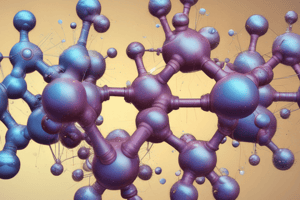Podcast
Questions and Answers
Which of the following is the correct general formula for the reaction between an acid and a carbonate?
Which of the following is the correct general formula for the reaction between an acid and a carbonate?
- acid + carbonate -> salt + hydrogen + carbon dioxide
- acid + carbonate -> salt + water + carbon dioxide (correct)
- acid + carbonate -> metal + water + carbon dioxide
- acid + carbonate -> base + water + carbon dioxide
In a precipitation reaction, soluble reactants combine to form an insoluble product, which then precipitates out of the solution.
In a precipitation reaction, soluble reactants combine to form an insoluble product, which then precipitates out of the solution.
True (A)
What two processes are used to isolate the salt product from the remaining solution after a reaction between an acid and a carbonate?
What two processes are used to isolate the salt product from the remaining solution after a reaction between an acid and a carbonate?
filtration and crystallisation/evaporation
The reaction of silver nitrate with sodium chloride produces insoluble silver chloride and ______.
The reaction of silver nitrate with sodium chloride produces insoluble silver chloride and ______.
Match the method of salt preparation with its description:
Match the method of salt preparation with its description:
Which of the following statements accurately describes the behavior of litmus paper in the presence of an acid and a base, respectively?
Which of the following statements accurately describes the behavior of litmus paper in the presence of an acid and a base, respectively?
All bases are alkalis, but not all alkalis are bases.
All bases are alkalis, but not all alkalis are bases.
What two products are generally formed when an acid reacts with a metal?
What two products are generally formed when an acid reacts with a metal?
The reaction between an acid and a base is known as __________, and it results in the formation of a salt and water.
The reaction between an acid and a base is known as __________, and it results in the formation of a salt and water.
Match the following reactants with the products they form in a chemical reaction:
Match the following reactants with the products they form in a chemical reaction:
During the preparation of soluble salts using acid/base reactions, what indicates that the reaction is complete?
During the preparation of soluble salts using acid/base reactions, what indicates that the reaction is complete?
When preparing a soluble salt from an acid and a carbonate, which gas is produced as a byproduct of the reaction?
When preparing a soluble salt from an acid and a carbonate, which gas is produced as a byproduct of the reaction?
Crystallization is a method used to form a liquid salt from a solution.
Crystallization is a method used to form a liquid salt from a solution.
Flashcards
Carbonate Reaction Formula
Carbonate Reaction Formula
Acid + Carbonate -> Salt + Water + Carbon Dioxide
Example of Carbonate Reaction
Example of Carbonate Reaction
Hydrochloric acid and sodium carbonate react to produce sodium chloride, water, and carbon dioxide.
Precipitation Reaction
Precipitation Reaction
Mixing two solutions containing ions that form an insoluble compound.
Example of Precipitation Reaction
Example of Precipitation Reaction
Signup and view all the flashcards
Salts by Direct Combination
Salts by Direct Combination
Signup and view all the flashcards
Acids
Acids
Signup and view all the flashcards
Bases
Bases
Signup and view all the flashcards
Neutralisation
Neutralisation
Signup and view all the flashcards
Salts
Salts
Signup and view all the flashcards
Acid and Metal Reaction
Acid and Metal Reaction
Signup and view all the flashcards
Crystallisation
Crystallisation
Signup and view all the flashcards
Acid and Carbonate Reaction
Acid and Carbonate Reaction
Signup and view all the flashcards
Preparation of Soluble Salts (Acid/Base)
Preparation of Soluble Salts (Acid/Base)
Signup and view all the flashcards
Study Notes
- Acids, bases, and salts have distinct properties and can be prepared through various chemical reactions.
Properties of Acids
- Acids donate hydrogen ions (H+) or protons during chemical reactions.
- Acids turn litmus paper red.
- Acids react with metals to produce a salt and hydrogen gas: acid + metal -> salt + hydrogen.
- Acids react with carbonates to produce a salt, water, and carbon dioxide: acid + carbonate -> salt + water + carbon dioxide.
- Hydrochloric acid (HCl), sulfuric acid (H2SO4), and nitric acid (HNO3) are common household acids.
Properties of Bases
- Bases accept hydrogen ions (H+) from other substances.
- Most bases are metal oxides or metal hydroxides, examples include zinc hydroxide [Zn(OH)2] and copper(II) oxide (CuO).
- Bases turn litmus paper blue.
- When a base dissolves in water, an alkali is formed.
- All alkalis are bases, but not all bases are alkalis.
- Neutralization is the reaction between an acid and a base in order to form a salt and water: acid + base -> salt + water.
Properties of Salts
- Salts form when the hydrogen of an acid is replaced by a metal ion or an ammonium ion.
- Salt naming is determined by the acid and base reactants.
- The metal from the base is the first part of the salt's name, and the acid is the second part. Example sulfuric acid + sodium = sodium sulfate
- Salts can be made by reacting an acid with a base, a metal, or a carbonate.
- Crystallization is a common method for forming a solid salt from a solution, and it involves evaporating the water until the salt crystallizes.
- Most salts are solid and crystalline at room temperature, characterized by high melting and boiling points.
Preparation of Soluble Salts using Acid/Base Reactions
- Soluble salts are prepared by reacting an acid with a base through neutralization where acid + base -> salt + water.
- Sulfuric acid and sodium hydroxide create sodium sulfate: H2SO4 + 2NaOH -> Na2SO4 + 2H2O.
- The completion of the reaction is confirmed by the cessation of fizzing or an excess of acid.
- Heating the mixture evaporates water to yield the salt.
Preparation of Soluble Salts using Acid and Carbonates
- Reacting an acid with a metal carbonate or a hydrogen carbonate also produces a soluble salt.
- The general formula is: acid + carbonate -> salt + water + carbon dioxide.
- Hydrochloric acid reacts with sodium carbonate to produce sodium chloride: 2HCl + Na2CO3 -> 2NaCl + H2O + CO2.
- Filtration separates the salt product, where crystallization or evaporation then obtains the salt from the filtrate.
Preparation of Insoluble Salts using Precipitation Reaction
- Precipitation reactions prepare insoluble salts and occur when two solutions containing ions combine to form an insoluble compound.
- Silver nitrate (AgNO3) and sodium chloride (NaCl) produce insoluble silver chloride (AgCl): AgNO3 + NaCl -> AgCl + NaNO3.
- Filtration collects the insoluble salt (precipitate).
- Any remaining ions are then washed away, and the precipitate is dried.
Alternative Preparation of Salts
- Salts can also be prepared by:
- Direct combination of an element with an element
- An element with a compound
- A compound with a compound.
- Combining chlorine gas with sodium metal produces sodium chloride: 2Na(s) + Cl2(g) -> 2NaCl(s).
Studying That Suits You
Use AI to generate personalized quizzes and flashcards to suit your learning preferences.
Description
Explore acid and carbonate reactions, precipitation processes, and salt isolation techniques. Understand the general formula for acid-carbonate reactions and identify byproducts. Match salt preparation methods with their descriptions.




